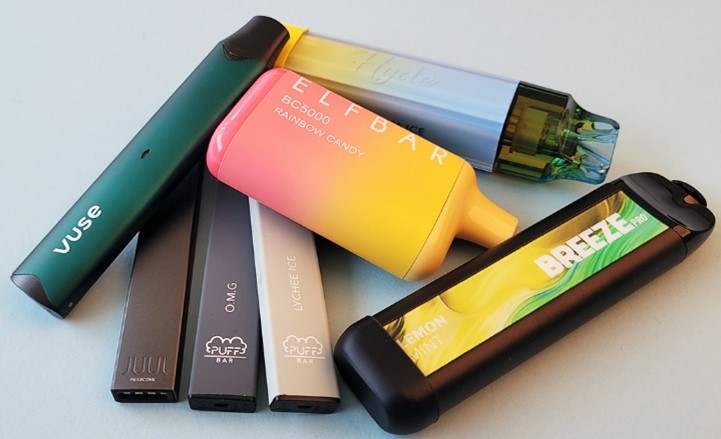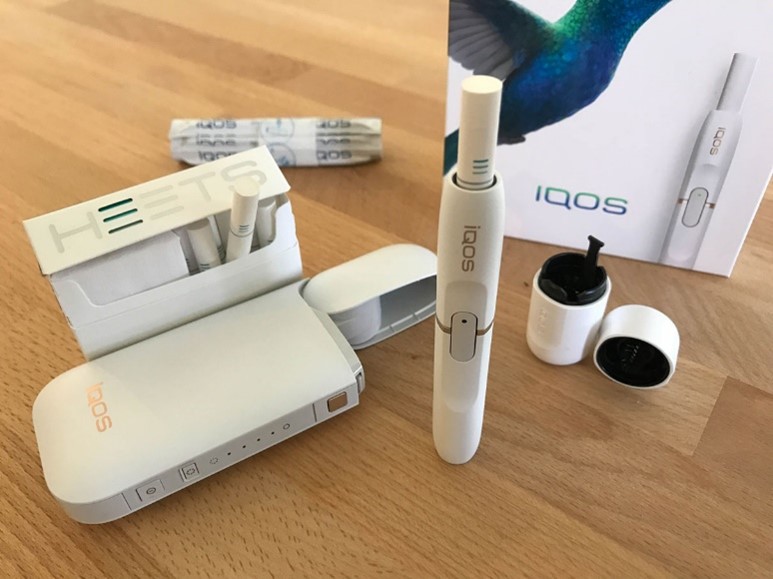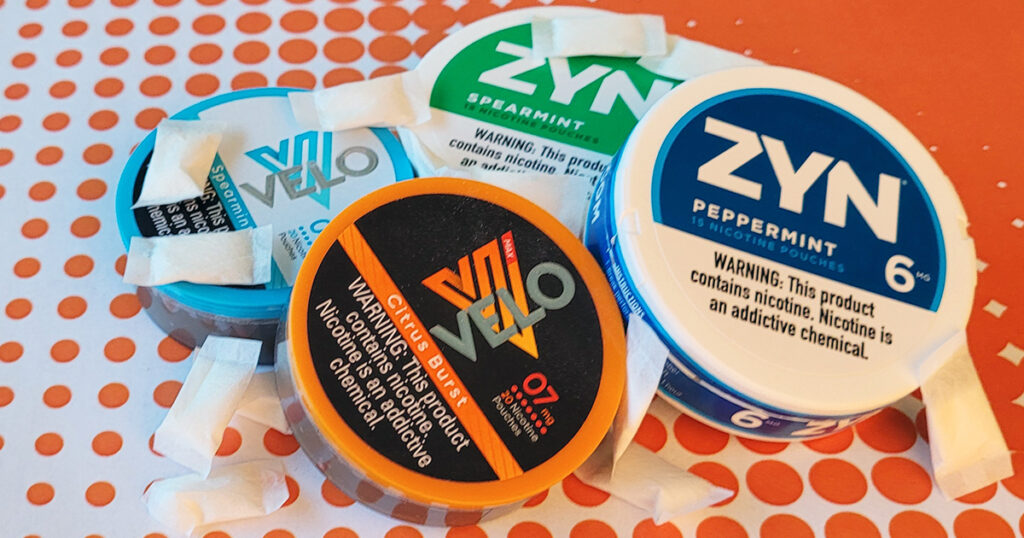What you need to know about the latest tobacco and nicotine products on the market

Written by: Susan Vileta, Health Educator, Johnson County Public Health
Lung cancer is one of the leading causes of preventable cancer death in Iowa. Smoking is by far the leading risk factor for lung cancer. This blog aims to provide general information about the latest tobacco and nicotine products on the market.
E-Cigarettes

E-cigarettes can resemble traditional tobacco cigarettes, cigars, or pipes, or even everyday items like pens or USB memory sticks.
E-cigarettes are sometimes called “e-cigs,” “vapes,” “e-hookahs,” “vape pens,” and “electronic nicotine delivery systems (ENDS).” While some e-cigarettes look like regular cigarettes, cigars, or pipes, others can look like USB flash drives, pens, and other everyday items.
E-cigarettes heat liquids that typically contain nicotine derived from tobacco, as well as flavorings and other ingredients, which produce an aerosol (Note: Nicotine is the addictive drug in regular cigarettes, cigars, and other tobacco products). Users inhale this aerosol into their lungs and bystanders can also breathe in this aerosol as the user exhales into the air.
Scientists know that vaping coats the lung with a toxic cocktail that may contain:
- Carcinogenic chemicals – some of the volatile organic compounds (VOCs) commonly found in vapor, such as benzene and heavy metals, are known to cause lung cancer and pose other health risks.
- Diacetyl – A food additive, this butter-flavored liquid is generally safe to ingest. However, when inhaled directly into the lungs, it can cause scarring in the air sacs, which in turn can cause the airways to thicken and narrow (“popcorn lung”).
- Ultrafine particles – When inhaled deep into the lungs, tiny particles can become lodged in the trachea and bronchi and worsen respiratory conditions, such as asthma.
- Nicotine – A stimulant drug as addictive as heroin or cocaine, making it extremely difficult to quit. Those who start smoking or vaping before age 21 have the hardest time breaking the habit.
The e-cigarette market is currently flooded by numerous brands of candy and fruit flavored disposables. This is in part due to the Food and Drug Administration’s (FDA) restriction of flavors in cartridge based reusable vapes to only menthol and tobacco flavor in early 2020.
E-cigarettes can be used to deliver marijuana and other drugs.
Heated Tobacco

Heated tobacco products generally heat dry tobacco to create an aerosol that is inhaled by the user
Heated tobacco products are not the same as e-cigarettes. Heated tobacco products generally heat dry tobacco to create an aerosol that is inhaled by the user (also called non-combusted cigarettes or heat-not-burn products). The global market for this type of product is small, but growing, and being sold in over sixty-one markets across Europe, North and South America, Asia and online.
In the United States, Phillip Morris (maker of Marlboro), has the exclusive rights to sell a heated tobacco product called IQOS. They may hit the U.S. market again in 2024. Learn more.
The latest body of research suggests that heated tobacco products and their emissions contain many of the same harmful ingredients as regular cigarettes, and potentially other harmful ingredients not present in regular cigarettes. Additional research is needed.
Nicotine Pouches

Menthol tobacco products make up approximately 39% of the overall cigarette market.
Nicotine pouches are often marketed as tobacco-free which can make people, especially youth, think they are harmless. They are used similarly to snus which is a small pouch of shredded tobacco leaf placed in the mouth between gums and cheek. However, nicotine pouches contain nicotine powder instead of tobacco leaf. They can have a high level of nicotine, and nicotine is harmful to a developing brain, especially the parts that control attention, learning, mood, and impulse control. Nicotine use can also make symptoms of depression and anxiety worse.
Menthol
Menthol and other flavors have been introduced into products to ‘hook’ young people on tobacco and nicotine products. Menthol comes from the peppermint plant and is a mild anesthetic found in household items like toothpaste, cough drops and mouthwash. It is added to tobacco and nicotine products because of the minty flavor, and it reduces inflammation in the throat, making it easier to breathe more deeply into the lungs.
Menthol tobacco products make up approximately 39% of the overall cigarette market. The tobacco industry has intentionally marketed to the following communities through neighborhood advertising, coupons, lower pricing, and financial donations to the organizations in which they belong:
- Black (85% of Black adults who smoke use menthols)
- Hispanic
- Female
- Youth (More than ½ of all 12-20 year olds who use cigarettes start with menthol cigarettes and 90% of Black teenagers who smoke use them)
- LGBTQ
- Low-socioeconomic Status
Menthol-flavored cigarettes have been removed from the market in the European Union, United Kingdom, and Canada. In the United States, they have been removed in some cities, counties, and states, but not nationally.
Ways to get Involved:
- The American Cancer Society hosts the annual Great American Smokeout on the third Thursday in November. It’s a day to jump start your journey towards a tobacco/nicotine-free life – taking an important step toward a healthier life and reducing your cancer risk.
- Talk with the youth in your life about the potential harms associated with tobacco and vaping.
- Use or share FREE quitting resources like My Life My Quit or Quitline Iowa,
- Join a local tobacco/vaping prevention and control coalition near you! In Johnson County, contact CAFE (Clean Air for Everyone) by contacting Susan Vileta at 319-356-6040 or [email protected].
Reference List
- Anderson SJ. Marketing of Menthol Cigarettes and Consumer Perceptions: A Review of Tobacco Industry Documents. Tob Control. 2011;20 Suppl 2(Suppl_2):ii20–ii28. doi: 10.1136/tc.2010.041939
- Goodwin RD, Ganz O, Weinberger AH, Smith PH, Wyka K, Delnevo CD. Menthol Cigarette Use Among Adults Who Smoke Cigarettes, 2008-2020: Rapid Growth and Widening Inequities in the United States.
- Marynak KL, Gammon DG, Rogers T, Coats EM, Singh T, King BA. Sales of Nicotine-Containing Electronic Cigarette Products: United States, 2015. American Journal of Public Health 2017; 107(5):702-705.
- Masaki, K., Taketa, R. M., Nakama, M. K., Kawamoto, C. T., & Pokhrel, P. (2022). Relationships Between Depressive Symptoms, Anxiety, Impulsivity and Cigarette and E-cigarette Use Among Young Adults. Hawai’i journal of health & social welfare, 81(3), 51–57.
- Nicotine Tob Res. 2020 Oct; 22(10): 1673–1675. Published online 2020 Sep 12. doi: 10.1093/ntr/ntaa152
- Nicotine Tob Res. Mar 22 2023;25(4):692-698. doi:10.1093/ntr/ntac214
- Reuters. Philip Morris signals slower US roll out for IQOS. September 28, 2023. https://www.reuters.com/markets/us/philip-morris-expands-smoke-free-ambition-updates-targets-2023-09-28/
- U.S. Department of Health and Human Services. E-cigarette Use Among Youth and Young Adults: A Report of the Surgeon General. [PDF–8.47 MB] Atlanta, GA: US Department of Health and Human Services, Centers for Disease Control and Prevention, National Center for Chronic Disease Prevention and Health Promotion, Office on Smoking and Health; 2016.
